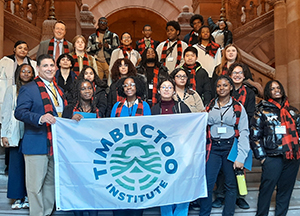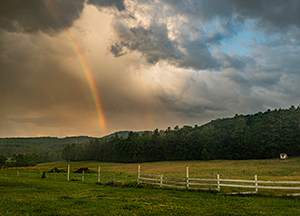
Creating Common Communication
By Blake Nuemann, Clean Water Advocate, and Julia Luna, Clean Water intern
Wednesday, August 24, 2022
As promised, this week we return with another prevention-focused blog exploring additional strategies the Adirondack Council is exploring and developing through its Clean Water work across the Park. Proactive or “preventative” solutions are often more cost-effective and efficient in addressing pressures to water quality, as compared to reactive solutions. This series will continue to provide insights into some of the tools used by lake associations and other partners across the region to address these water quality pressures before they become unmanageable.

Informing and Engaging Communities
Community engagement is an essential step in any governmental decision-making process, though this step can often be mired in bureaucracy and laden with emotional baggage or distrust, especially for communities that feel their perspectives have historically been overlooked during these exercises. Giving communities the tools, knowledge and resources to understand and engage in these processes often is beneficial not only in the process surrounding the resolution of an issue, but in the long-term efficacy of the solution. Providing these tools, knowledge and resources is an extremely effective prevention-focused strategy for improving decision-making processes and resulting outcomes.
From the launch of our Raquette Lake Watershed pilot work, we have prioritized informing and enlisting the public to make decision-making processes more equitable, transparent and effective in this watershed. Working at the watershed scale offers a unique opportunity to see how an environmental decision can impact a community (or communities) through the many different perspectives of the individuals that are often most heavily impacted by those decisions. These perspectives often form a complex and multi-faceted mosaic; however, given enough time, making sense of this jumble of information can be extremely valuable and informative in how our legislators make key decisions or inform their policy-making.
Filling in the Gaps
Much of our work in the Raquette Lake Watershed is centered around understanding how lake associations currently interface with government entities and (importantly) how they would prefer to interface with those entities, as well as what support they need to accomplish their essential work. Many lake associations rely on regional conservation organizations to provide them with the tools and knowledge being offered to other “boots-on-the-ground” (ie. the folks involved in the day-to-day activities of managing invasive species or water quality) practitioners around the Park. Our conservation practitioner partners working across the Park fill vital information gaps by providing hands-on trainings, opportunities for public education, publications for a variety of audiences and helpful guidance to lake associations, as well as collecting heaps of data. However, our pilot work has indicated that support gaps may still exist outside the scope of the assistance currently on offer.
These shortfalls have become the focus of our long-term planning efforts, determining which of these gaps can be filled by technical support or funding from state, county or municipal government; or alternatively, which gaps may benefit from the development of dedicated resources that would be useful to a wider set of users. Thus, the Council’s recent focus in working with lake associations (primarily the Raquette Lake Preservation Foundation) has been to get a better sense of best management practices across a variety of topics and begin thinking of ways that we can aggregate the most helpful insights into a common framework for lake associations across the Park to use.

Help on the Horizon
In order to understand how we can push for the development of best management practices, it is important to highlight that lake associations work at the interface between large-scale conservation goals and the local community setting. Lake Associations play a crucial role in actualizing the broad-reaching conservation goals of the state, while also being responsive to their communities. It’s important to acknowledge that due to their strong place-based ties, lake associations vary a lot from each other in both organizational structures, as well as conservation and outreach priorities. Most lake associations are volunteer-run and although they are active year-round, most of the activity occurs during the summer. Their unique situation within the conservation landscape means that the value of their work is often under-resourced despite their unique impact at a variety of scales.
When talking to lake associations around the Park (such as RLPF), some of the resource needs they expressed such as projectors, interpretive signage, divers, website development – and the list goes on – may initially seem like surprising requests to a conservationist conditioned to think about policies and regulations. However, by taking the time to listen to these needs, it quickly becomes apparent that these are all important tools in helping lake associations maintain membership and engage in their community, ultimately impacting their ability to practice conservation. In response to this feedback, we have begun working on a “Webplanning Toolkit” to support lake associations with website development and maintenance. The objective is to help lake associations standardize some of their communication goals by providing them with a basic framework of an idealized lake association website. However, we purposely left this toolkit open-ended enough to allow the individuality and creativity of each distinct association to take the helm of their web outreach strategy.
Tell us your insights!
Lake Associations provide one of the most important components in carrying out the conservation goals of the state: the boots on the ground. By standardizing some of the ways that these entities are able to collect and communicate information about the well-being of their lakes, we hope to see a more seamless through line emerge. Ultimately, this type of resource will provide an opportunity for stakeholders to coalesce around shared interests and concerns at the watershed scale, communicating how these priorities translate to funding and/or technical assistance needs at the municipal, county and state levels. As our Clean Water work in the Raquette Lake Watershed moves forward, we hope to continue learning more about these critical gaps – and would love to hear from your lake association, if you have a perspective on this!




